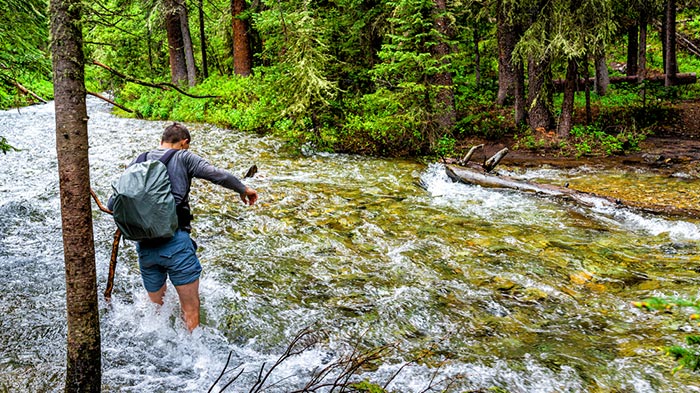Fording a stream while back-country trekking can be as simple as an ankle-deep wade through a gentle riffle to a potentially dangerous crossing of a rock-strewn, strong-current river. There are several factors to consider; procedures to take; to help you make the safest, smartest crossing possible.
Determining the Crossing Site
If the water is above your thighs, it's too deep! Knee-deep is better.
Assess the rate of water flow toss in a stick, if it moves faster than you can keep up with it walking along the bank, the current's too fast.
Toss in a fist-sized rock if it makes a hollow, ker-plunk sound; the water's too deep. If you toss in a rock and you can see it arching forward as it sinks, or hear rocks rolling along the bottom, it's too fast.
Check your map, rivers are usually shallower at their widest point. Also be aware of hazards downstream (either use map or scout before crossing).
Calm water often means deeper water.
Assess bottom of water channel: boulders, slippery rocks, debris, etc.
Preparations for Crossing
Unbuckle your pack for quick, easy removal should you fall into stream.
Consider footwear: regular boots dry faster than waterproof ones (and if water is deeper than top of boot, they get wet inside anyway).
Secure, but easy to remove, footwear (if foot becomes lodged in rocks, debris, you should be able to remove your foot if boot is too tightly wedged in place;
Find a stout walking staff to provide support and balance while crossing.
Making the Crossing
Face upstream, stepping sideways across current, path should be angled downstream.
In any group, strongest person takes the lead in crossing.
For a small group (3 people) face inward, leader upstream, form a tripod and cross as a unit.
A larger number of hikers can form a line, one behind the other, in line behind strongest person, all facing upstream and using the disturbance of water (eddies) created by each person to disperse the force of the current, group side-steps across stream.
Groups can align behind leader, shoulder to shoulder parallel to flow and using poles, slowly move line towards opposite bank.
In some instances, send strongest across and set up taut line for a hand-hold and/or to move gear across to other side.
If You Fall While Crossing
Not only should you plan where to cross, and how to cross, but equally important is to have a plan for what to do if you fall while crossing.
Face downstream with your feet braced in front of you.
Keep your hands free to guide/direct you past obstacles.
Keep your head tilted forward to visually see your route downstream.
It's important to know how to access a river for crossing and to think ahead before you attempt to ford a stream. When in doubt, choose another crossing point or seriously reconsider your route.
Most importantly, Be Smart; Be Safe; Have Fun!





